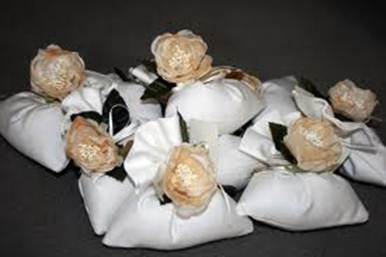|

Why does a bride wear a flowing, white gown with a
matching veil? Why she is on the left and the groom stands to her right? Why
the garter?
Each culture, ethnic group and nation has
its own unique traditions surrounding marriage and wedding ceremony and all are
as diverse and varied as the bride and groom.
May traditions have been handed down
through the ages without question; many of them have little, if any, personal
meaning to modern brides.
Many couples today are talking the
contemporary route, leaving tradition by the wayside while opting to design
their own ceremonies and writing their own vows.
Regardless of how “old fashioned” the
traditional ceremonies are perceived, they are still the most popular today.
What does it mean?

The brie’s veil, which was yellow in
ancient Greece and red in ancient Rome, covered her from head to foot and once
denoted the subordination of woman to man. It also kept the groom from seeing
her face during the ceremony. Not only could the groom not see in, but, the
bride could not see out, requiring her father to escort her down the aisle and
literally “give her away.”
- In 860 AD, Pope Nicholas 1 decreed that
an engagement ring become a required symbol of nuptial intent, insisting
that it be made of gold, indicating a financial sacrifice of the
prospective husband.
- Medieval Italians believed that because
the diamond was the hardest and most enduring substance in nature, it symbolized
that ensuing marriage would last forever.
- Gold was highly prized in ancient Rome,
therefore, a gold band signified everlasting love and commitment. Earlier
legend has it that husbands wrapped circles of braided grass around his
bride’s wrists and ankles, believing it would keep her spirits from
leaving her.
- The bands later evolved into leather,
carved stone, metal, then silver and gold and worn just on the finger.
- Centuries ago, it was believed that the
third finger on the left hand was connected by a vein running directly to
the heart.
- Many times, a father who didn’t approve
of his daughter’s marriage, reused to provide a dowry for her, so her
friends “showered” her with gifts, to show moral support.
- The ages-old term “tie the knot” came
from Rome, where brides wore girdles tied in many knots and it was the
groom’s “duty” to untie them following the ceremony (in private chambers,
of course.)
- While some brides were kidnapped,
marriage by purchase was preferred. The price for a bride could be land,
social status, or cash.
- The root word for “wedding” stems from
the Anglo-Saxon language and literaly means “to wager or gamble.”
- The color white has been a symbol of
joyous celebration since early Rome and once stood for purity.
- In ancient times, a groom “kidnapped” his
bride and positioned her at his left side to protect her, which fed his
right hand to draw his sword if suddenly attacked or ambushed by the
bride’s father.
- The wedding cake custom originated also
in early Rome, where a loaf of bread was broken over a bride’s head to
symbolize hope for a fertile and fulfilling life. Guests ate the crumbs,
which were believed to bring them good luck.
- In England, during the Middle Ages,
guests brought small cakes to a wedding and put them in a pile, over which
the bride and groom later stood while kissing. The idea emerged to pile
all the cakes together and frost them, thus creating the idea of
multi-tiered wedding cakes.
- In Anglo-Saxon times, the groom’s friends
helped him capture or kidnap his bride, while the bride’s friends helped
her escape her over protective family or other suitors; thus, the need for
attendants.
- Something old, something new, something
borrowed, something blue. Old represented ties to a bride’s past; new,
hope for the future; borrowed signified long lasting dependable
friendships and blue represented faithfulness.
- In the 14th century, it was
customary for the bride to toss her garter to the men before they became
drunk at the wedding pry and tried to remove it themselves. The custom
emerged that the groom remove and toss the garter to unmarried males. The
bride began tossing her flowers to unwed females. The one catching either
was thought to be next to marry.
- In ancient times, many marriages were by
capture, not choice. A man often carried an unwilling woman to a secret
place where her relatives couldn’t find them. While the moon went through
all its phases, (about 30 days) they hid away and drank a brew made from
honey. Hence, the word honeymoon.
- Brides were once considered property of
their fathers who arranged the marriage. Often, an unattractive woman was
matched to a prospective groom from another town without either of them
having seen each other. More than once, when the groom saw his future wife
for the first time on the day of wedding, he left her standing at the
altar. To prevent this from happening, it became “bad luck” for the groom
to see his bride prior to the ceremony.
- Fortunately, some of the more archaic
traditions have fallen by the wayside, but we see how bits and pieces
continue to be observed today.
- Many modern brides choose to continue
with frills and formalities, while others are choosing more contemporary
ceremonies that liberate her from those customs.
- Each bride must choose what suits her
best as she plans for the most wonderful day of her life.
- Whether she stands on the left or on the
right, wears a veil or a cowboy hat doesn’t really matter. It’s her
wedding, after all
|